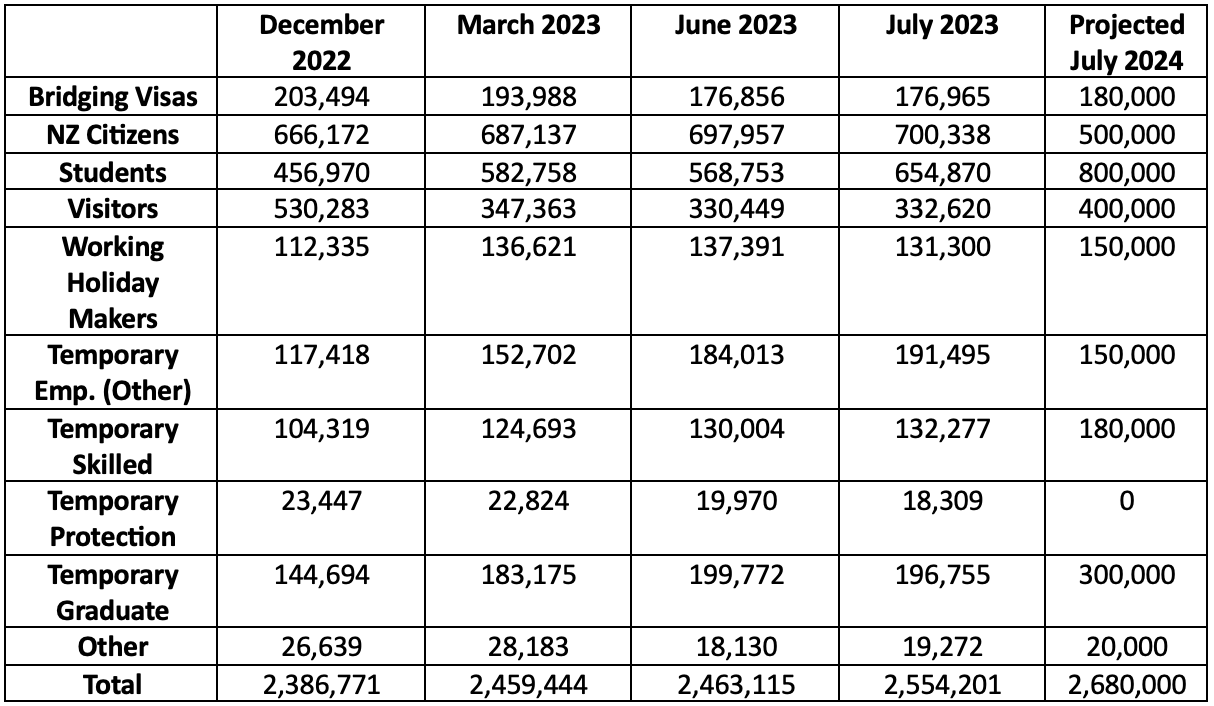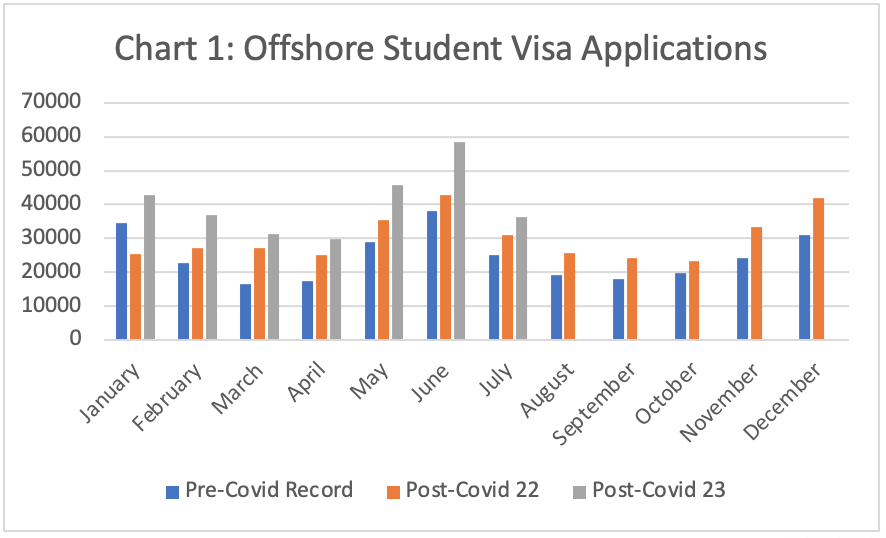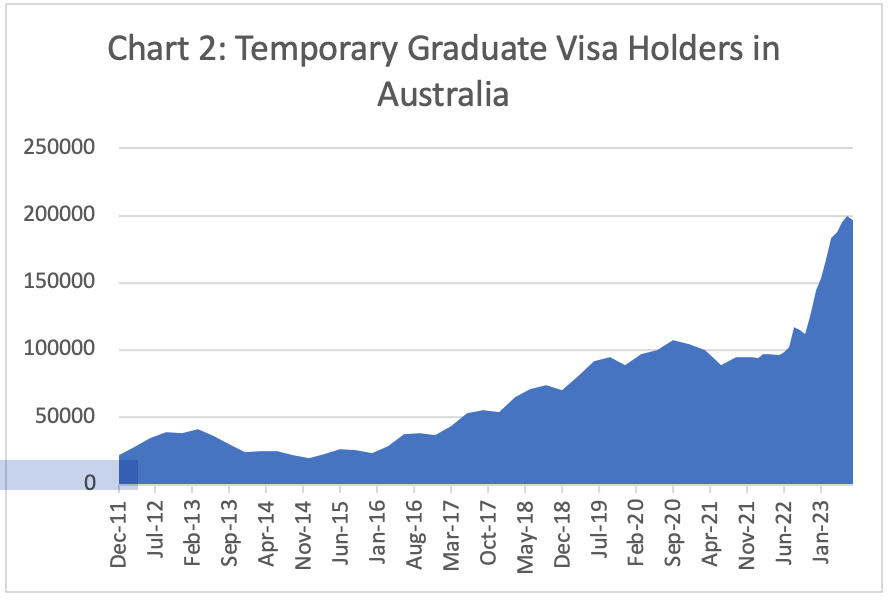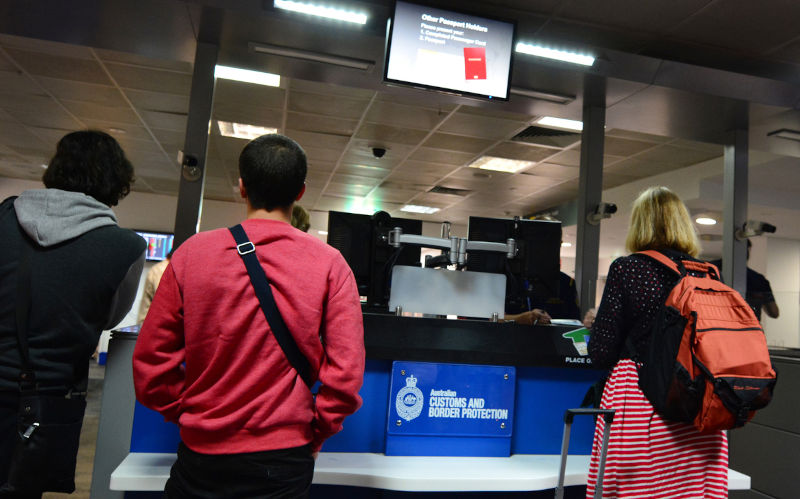Will number of temporary entrants in Australia continue to rise?
September 11, 2023
At end July 2023, there was an all-time record 2.554 million temporary entrants in Australia. The crucial policy question is whether that will be a peak or whether the number of temporary entrants in Australia will keep rising? If the latter, what will that mean for the number of temporary entrants in immigration limbo unable to secure permanent residence and unwilling to depart?
The increase in the number of temporary entrants in Australia slowed during the June quarter, predominantly because of an increase in student and visitor departures. In addition, there was a large net outflow of Australian citizens (mostly on overseas holidays).
That would have contributed to the weak GDP outcome in the June quarter. But the reference to a per capita recession in the June quarter is somewhat misleading because we will not know the actual outcome for net migration in the June quarter (as opposed to a very preliminary estimate) for another 6-12 months. Net long-term and permanent movements in the June quarter was much lower than the population clock (something of a gimmick) used by the ABS suggests.
In July 2023 there was a large surge in student and other temporary (employment) numbers leading to a record level of temporary entrants in Australia (see Table 1) as well as a net return of Australian citizens. This suggests net migration in the September quarter of 2023 will be much higher than in the June quarter (increasing the likelihood of another quarter of negative per capita GDP).
Table 1: Temporary Visa Holders in Australia

A crucial policy question is whether the rise in temporary entrants in Australia will continue and what portion of them may end up in immigration limbo?
Permanent migration
The Albanese Government says it prefers permanent migration over temporary migration. To that end, it has increased the permanent migration program to 190,000 (plus 3,000 places for the Pacific Engagement Visa). As around 60-70 percent of the program goes to people who are already in Australia, this is enabling a larger number of temporary entrants to secure permanent residence.
The Government has also increased the Humanitarian Program to 20,000 (around 2,000 for successful onshore asylum seekers and 18,000 for offshore entrants), plus a pathway to permanent residence for around 20,000 temporary protection visa holders who will not be counted as part of the permanent Humanitarian Program even though they will be granted permanent residence visas. By mid-2024, the number of temporary protection visa holders in Australia may be close to zero compared to the current 18,309.
It is also likely the Government will find a pathway to permanent residence for another 12,000 legacy boat arrivals who have been refused protection but will not be departing Australia. That will have no impact on net migration as these people have already been counted for that purpose. How they will be counted in terms of the Humanitarian Program is unclear.
NZ citizens
The Government has provided a direct pathway to Australian citizenship for NZ citizens who have lived in Australia long-term (more than four years). While the number of NZ citizens in Australia for the first time exceeded 700,000 at end July 2023, it is likely this will decline over the next 12 months as more NZ citizens acquire Australian citizenship. Conversion to Australian citizenship does not affect net migration nor permanent migration places but the rising flow of NZ citizens to Australia in recent months will add to net migration. The driver will be the relative state of the labour market in the two nations.
The total number of NZ citizens in Australia may fall to around 500,000 by the end of 2023.
Students, temporary graduates and other former students
Offshore student visa applications have grown at record rates over the past 18 months (see Chart 1). That has enabled student numbers in Australia to rise to a record 654,870 by end July 2023.

There have also been reports of fraud and rorting, including in the Parkinson and Nixon Reports. The Government has moved gradually to tighten student visa policy, including again restricting student work rights from 1 July 2023, address other student visa rorts and belatedly close down the special covid visa stream that was being used by students to access full work rights without having to study or pay tuition fees.
The Government has indicated it will introduce further tightening of student and other visas in the coming months. But it would be surprising if it tightened to such a degree that the growth in student visa holders in Australia stopped in the next 12 months. Any sudden tightening would be strongly opposed by the international education industry. Acceptable policy tightening usually takes time to take effect.
It is also likely a substantial number of covid stream visa holders will secure student visas, particularly to do an aged/disability care Certificate III to access the new Aged Care Labour Agreement. Covid stream visas will begin to expire over the next 12 months forcing these visa holders to find another visa option or depart. Some will apply for asylum to extend stay in Australia.
On the whole, it is likely the number of student visa holders in Australia may reach 800,000 by end July 2024.
As students complete their courses, a substantial portion will secure temporary graduate visas. The Albanese Government has streamlined access to these visas and extended their duration. This has resulted in a strong rise in the number of such visa holders to around 200,000 at end July 2023 (see Chart 2). With the rapid rise in student visa holders, a significant portion of completing students will move onto temporary graduate visas over the next 12 months compared to either departing or securing permanent residence.
It would not surprise if the number of temporary graduate visa holders by end July 2024 increased to over 300,000.

Working holiday makers (WHM) and pacific Australia labour mobility (PALM) scheme
WHM numbers have increased steadily over past 18 months but are still short of pre-pandemic peaks. The Parkinson Review recommended limiting WHM visas to one, one year visa only. That would significantly reduce WHM visa holders in Australia but would be strongly resisted by the tourism industry as well as the agriculture industry. It would be surprising if the Albanese Government was prepared to further antagonise both these industries. It would also require consultation with a range of WHM agreement countries so could not happen quickly.
If the labour market remains relatively strong, it is likely the number of WHMs in Australia will continue to rise and may be over 150,000 by end July 2024. This is specially the case as WHMs are now able to secure further WHM visas by working in industries other than agriculture.
Partly to offset the consequent loss of WHMs to the agriculture industry, the Government is ramping up the PALM visa. That will add to the number of temporary entrants in the Employment (Other) group offset by a reduction in covid stream visa holders.
Overall, it is likely the number of temporary entrants in the Employment (Other) group may fall to 150,000 by end July 2024. Note that around 300 PALM visa holders per month (within a total of around 2,000 asylum applications per month) are likely to apply for asylum during 23-24. PALM visa holders have few pathways to permanent residence and are rarely going to be happy doing tough work, in severe heat for very low pay. While their asylum claims are assessed, they will be placed on bridging visas. That would increase the number of bridging visa holders in Australia and increase net migration.
Temporary skilled visa holders
Temporary skilled visa holder numbers have not increased anywhere near the degree that would be expected given the strength of the labour market. That is due to a number of factors including streamlining of pathways to employer sponsored permanent migration. Future numbers in this category will be driven down by:
- Increase in the minimum salary requirement will reduce demand;
- Extended stay on temporary graduate visas leading to fewer former students having to use the skilled temporary visa as a pathway to permanent residence; and
- Possible weakening of the labour market.
These downwards pressures will be offset by the new Aged Care Labour Agreement which will increase the number of aged care workers using the temporary skilled visa. The overall impact will likely lead to an increase in the number of skilled temporary visa holders to around 180,000 by end July 2024 but that will then either stabilise or decline as these aged care workers secure permanent residence.
The number of skilled temporary entrants by end July 2024 may reach 180,000.
Visitors
As overall visitor movements start approaching pre-pandemic levels by the end of 2023, there should also be a gradual increase in the number of visitors in Australia. This will certainly rise to a new peak by the end of 2023, particularly through an increase in visitors from China, and then again decline as visitors depart in the new year.
By end July 2024, visitor numbers in Australia may be around 400,000.
Implications for policy and politics
With tightening of monetary and fiscal policy gradually taking increased effect and a higher level of net migration in the September quarter compared to the June quarter, it is highly likely per capita GDP in the September quarter will be negative. The media will then report we have had three consecutive quarters of negative per capita GDP (even though the June quarter was not negative if more accurate net migration estimates are used).
For the longer-term, the Albanese Government has gradually removed covid era immigration policy settings and introduced other policy tightening. It is likely to introduce further tightening in the coming months. That will reduce net migration for the whole of 23-24 which is highly unlikely to reach the revised Treasury forecast of 315,000 (just as net migration is unlikely to reach the revised Treasury forecast of net migration in 22-23 of 400,000) but will be well above the long-term assumption of net migration of 235,000 per annum in the recent Intergenerational Report.
Because it moved to tighten immigration policy too slowly, the Government now finds itself in a bind. To reduce the number of temporary entrants, particularly students and temporary graduates, in long-term immigration limbo, the Government would need to either:
- Increase the size of the Migration Program above current record levels that would be politically difficult, especially if the labour market weakens and the ABS continues to report per capita recessions; or
- Find a way to encourage a very large number temporary entrants who have been in Australia long-term and have invested significantly in a pathway to permanent residence to depart.
By the time of the next Election, the Government may find itself between a rock and a hard place on immigration policy generally, as well as on asylum policy which will be Labors Achillies heel.

